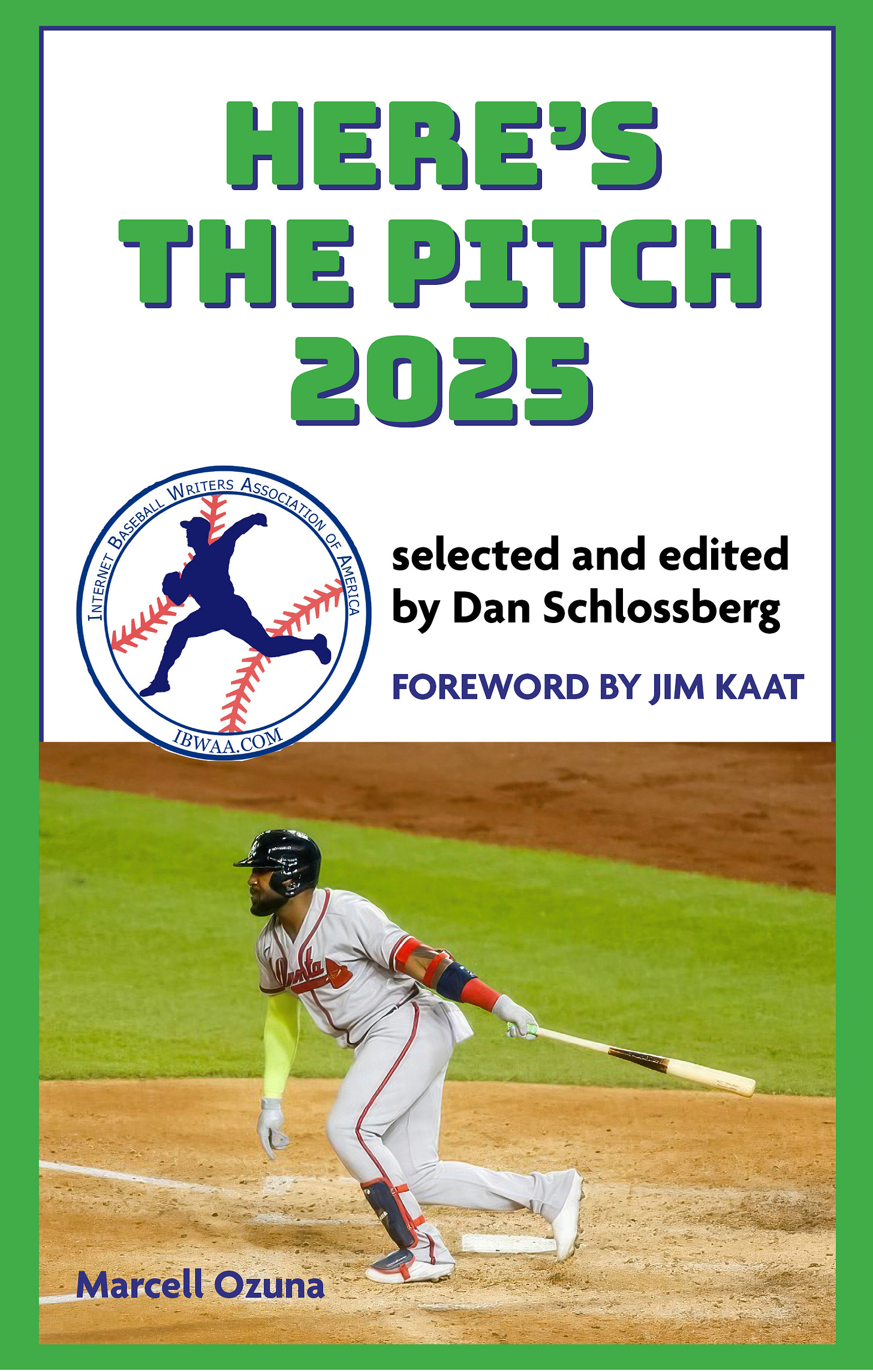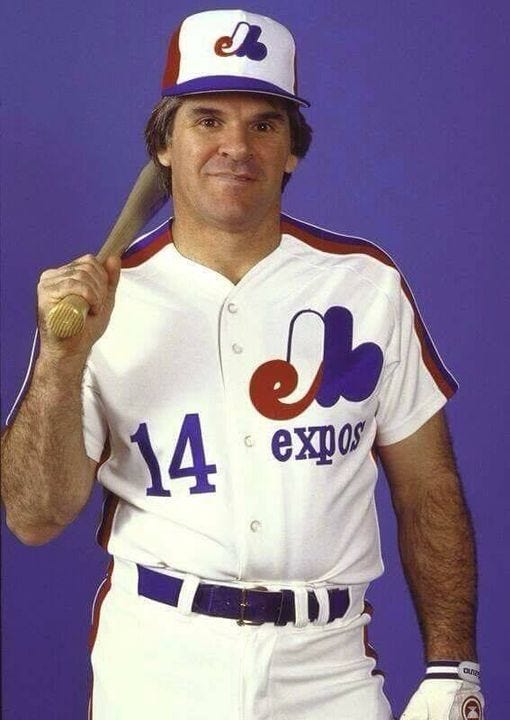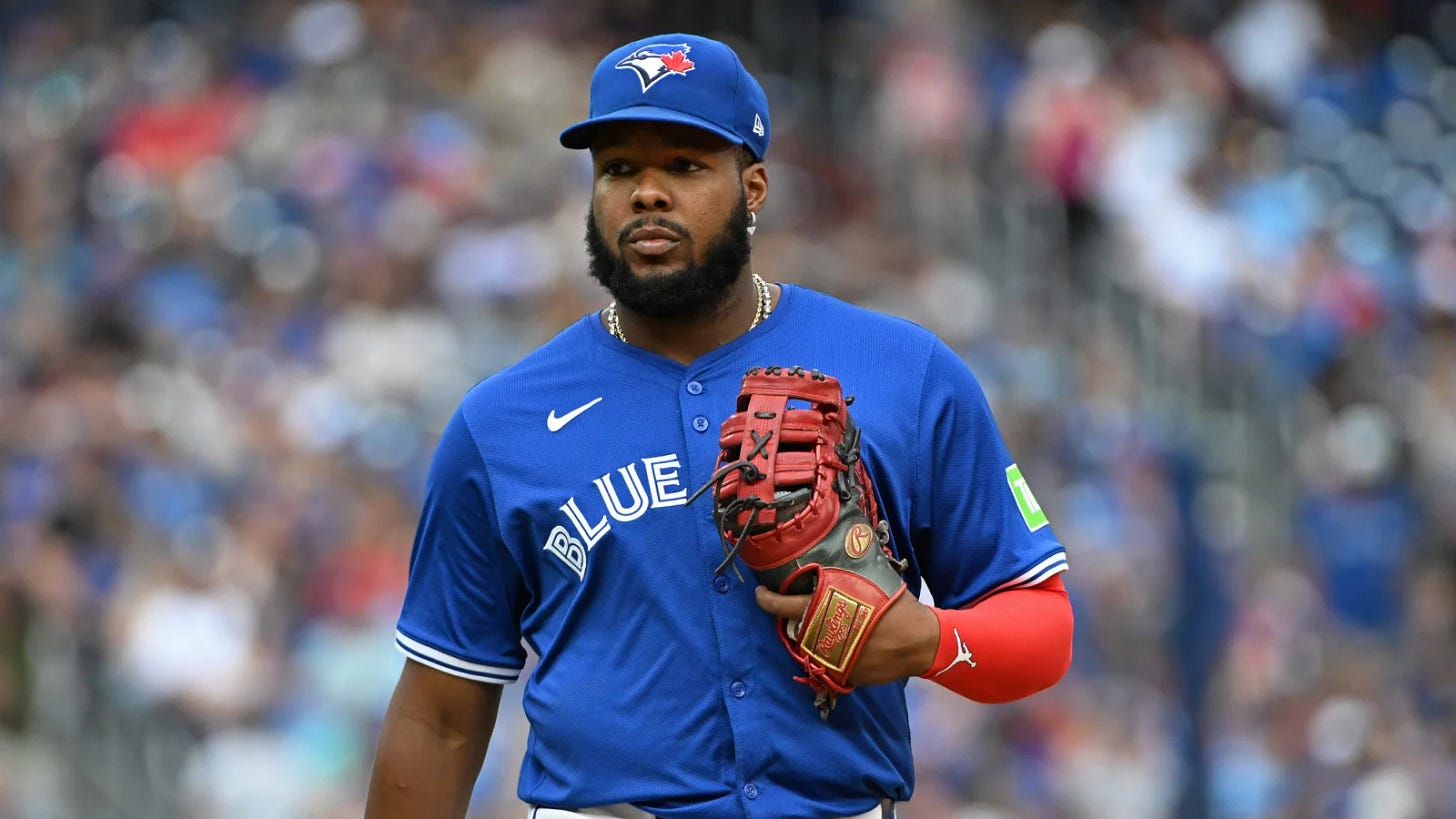Gambling In Baseball Poses Big Problems
ALSO: BLUE JAYS FACE TOUGH DECISIONS OVER POTENTIAL FREE AGENT DEFECTORS
IBWAA members love to write about baseball. So much so, we've decided to create our own newsletter about it! Subscribe to Here's the Pitch to expand your love of baseball, discover new voices, and support independent writing. Original content six days a week, straight to your inbox and straight from the hearts of baseball fans.
GET HERE’S THE PITCH 2025
Selected and edited by Dan Schlossberg
(215 pp., $24.95)
This first annual collection of 35 great baseball stories, analysis, memories, and trivia for the baseball fanatics on your gift list (including you) is available now for $24.95 athttp://www.actasports.com.
But subscribers to this newsletter get 10% off on one copy or 20% off on two or more copies by calling 800-397-2282, talking to a real live person (not an AI robot), and ordering directly from the publisher. Offer good only through March 1, 2025!
Reader Reacts to Criticism of Dodger Spending
“Please.just.stop.
You and all the other pundits are completely missing the point.
First of all, the Dodgers don't ‘spend,’ they invest. If I hear one more time the Dodgers "spent a billion dollars" last off-season, my head is going to explode. They agreed to pay Ohtani 700 million, 95% of which they won't have to part with for 10 years. In the meantime, in the first year of that contract they made 120 million off the guy, none of which they have to share with anybody. By the time they start paying him that $680 million, they will have made BILLIONS off this contract specifically.
That's not spending. That's investing. You act like they're buying luxury handbags or something.
The story here isn't that the Dodgers are spending. It's that because LA is a big, diverse, inclusive (read liberal) place; people want to be here. And it's not just baseball.
Some 60-70% of NBA players live in Los Angeles, regardless of what team they play for. A recent survey found that if money wasn't an issue, LA is #1 on the list of where Americans would want to live. Hell, half the Saudi royals have houses here.
As a result, players are worth more here than everywhere else (including NY). So much so they agree to play for free as Ohtani (making 70 million a year outside of his salary), and Sasaki (projected to get a good way to that figure before he's eligible for arbitration) have essentially done.
And no salary cap is going to change that. No billionaire owner crying poverty over the Dodgers is going to change that.
As for the fans, the problem the crybabies have isn't with the Dodgers. It's with capitalism and the free market.
And that, Mr. McManaman, for better or worse, is America.
— Drew Kern, Santa Monica, CA
Pregame Pepper
Did you know…
Even with Shohei Ohtani and Clayton Kershaw unable to pitch at the start of the season, the Dodgers will have a hard time squeezing an abundance of starters into their planned five-man rotation . . .
Blake Snell, rookie Roki Sasaki, and the returning Yoshinobu Yamamoto will certainly get the first three spots, with Tyler Glasnow No. 4, and Dustin May, Tony Gonsolin, and Bobby Miller the top three candidates to round out the front five for now . . .
Oft-injured pitcher Frankie Montas is up to his old tricks, suffering a lat strain that will keep him sidelined 6-8 weeks in the wake of his over-priced new Mets contract . . .
Former MVP Ronald Acuna, Jr. of the Braves admits he won’t be trying to steal bases so frequently as his torn left ACL heals . . .
Although Adam Duvall would be an excellent fourth outfielder and pinch-hitter, he’s still an unsigned free agent — with his age and apparent salary demands standing in his way . . .
The Royals did well to extend for three years the contract of budding star Cole Ragans.
Leading Off
The Cost of MLB’s Gambling Habit
By W.H. Johnson
CONDUCT IN PLAYING BASEBALL. Any player or person connected with a Club…and any player or person connected with a Club, who shall give, or offer to give, any gift or reward to an umpire for services rendered, or supposed to be or to have been rendered, in defeating or attempting to defeat a competing Club, or for the umpire’s decision on anything connected with the playing of a baseball game…” risks permanent disqualification from the game.
- MLB Rule 21
The sheer number of online outlets is dizzying. Since MLB authorized the website FanDuel.com to serve as an “Official Sports Betting Partner” in 2019 [to be fair, the other major sports were either already partnered or followed suit soon thereafter], the number of fantasy and wagering opportunities has exploded. No longer limited to merely FanDuel and DraftKings, an array of sports betting establishments have opened their figurative arms and accounts to welcome bettors from around the globe.
The results, at least for MLB, have been lucrative. In March 2024, per the website legalsportsreport.com, MLB had realized over an estimated one billion US dollars in fan engagement and other gambling-related revenue.
There’s an old saying, “you can’t un-ring a bell” that seems apt here. MLB owners are reaping the profits, largely passive, from sanctioning what has been forbidden throughout most of professional baseball’s history. Yet the risks to the game’s integrity should be obvious to even the most casual observer.
Gambling on baseball in the 19th century was one of the primary drivers for bringing the game to national prominence, in professionalizing the sport and thus enriching both executive and player, and in building fan interest in an otherwise passive, recreational activity. It helped turn a child’s game into an adult passion. It also tried to kill the sport in 1919 with the Black Sox scandal, and violations of the long-standing prohibitions on the activity have kept supremely talented players like Hal Chase, Joe Jackson, and Pete Rose from consideration for election to the Hall of Fame. As recently as 2024, Tucupita Marcano of the Padres was banned for life, and four minor leaguers were suspended for a season, for violating Rule 21. The temptation is real, even in the face of the risk of losing incredible opportunity.
Given the amount of money to be made, though, sports gambling is likely here to stay.
Except…
The dismissal of umpire Pat Hoberg, widely considered one of the better arbiters in the sport, for sharing an online gaming account with an acknowledged baseball bettor, ostensibly underscores MLB’s resolve to ensure that gambling does not encroach onto the diamond, and also somehow validates the vigilant oversight of all league employees when it comes to betting on baseball. Yet superstar Shohei Ohtani’s friend/interpreter allegedly stole millions from the player’s accounts to fund the latter’s gambling addiction. The theft, as reported by ESPN and others, was not revealed until after Ohtani discovered it. As the game revenues grow, and the opportunities to make a quick buck multiply, there will only be more violators of the rules. Some will inevitably succeed.
Cases like that of former NBA referee Tim Donaghy, who was so brazen as to bet on basketball games that he personally officiated, should be relatively simple to expose and correct. The lone-operative type of gambler, either player or official, would probably not survive the scrutiny from so many angles (reporters, fans, league security, and so on). But the second-order gambling opportunity, the heart of the previously-cited elements from Rule 21, that includes things like the inside information selling or the influence on other players or umpires to behave in particular ways, can be far more difficult to identify. And that is a problem.
Navy operations planners have long theorized that a minefield at sea needs only one mine to be effective. If it is seen or detonated, entire fleet movements stall until the area can be verified as ‘clear’. Actually, an effective minefield needs zero mines; if the threat is viable in the minds of the opponent, then the consequences are identical.
Such is the threat posed by legal gambling’s adjacency to professional baseball. Watch a critical pitch called a strike instead of a ball; a lazy fly ball dropped by a gold-glove outfielder; a swing at a pitch well outside the zone in a crucial count. Those events, and countless others, happen routinely over the course of every baseball season. Athletes and officials are human, and the possibility of physical or mental mistakes is always on the table. But what if fans begin to speculate about games being fixed? Fixed games have happened before, so why not again? There doesn’t have to be actual gambling-influence in a game for people to question the integrity of the entire sport.
That stench of rumor, even completely unfounded rumor, is awful, and no good for the future of baseball. Pat Hoberg got sacked. Shohei Ohtani was exonerated almost immediately. Those judgments seem, to some, a bit arbitrary, more about favoring those who can generate revenue than consistently enforcing an absolutely zero-tolerance policy toward something as potentially corrosive as gambling.
This is not a morality screed. Gambling can be exciting and can help make a White Sox—Rockies game in late August not only interesting but compelling. But the threat to baseball is undeniable. Just as has been the case with PEDs, enforcement of violations must be consistent and transparent to everyone.
Bill Johnson has contributed nearly 50 essays to SABR’s Biography Project, and presented papers at the 2011 Cooperstown Symposium on Baseball and American Culture, the 2017 and 2023 Jerry Malloy Negro League Conferences, and the inaugural Southern Negro League Conference. He has published a biography of Hal Trosky (McFarland and Co., 2017) and an article about Negro American League All-Star Art “Superman” Pennington in the journal Black Ball. He is on ‘X’: @menckensmemory
Cleaning Up
Blue Jays Are Better For Now But Not For Long
By Dan Schlossberg
Just when it looked like the Toronto Blue Jays would bounce back into contention for the American League East title, trouble has surfaced north of the border.
Vladimir Guerrero Jr., the team’s top star, says he won’t engage in extension talks beyond Feb. 18, the full-squad reporting date, and Dante Bichette, another Toronto mainstay, will also become a free agent this fall.
Unless they’re traded first, of course.
There would be no shortage of suitors for either.
The New York Mets would love to land Guerrero and have the money to meet his demands for a rich, long-term contract. Incumbent first baseman Pete Alonso just signed a two-year, $54 million deal that contains an opt-out clause that activates after this season ends.
The Boston Red Sox, where The Green Monster would make an inviting target for the right-handed slugger during home games in Fenway Park, are a perfect spot for Guerrero too.
So are teams that play in hitter-friendly ballparks, including the Phillies (Citizens Bank Park), Reds (Great American Ballpark), Astros (Daikin Field), and Rockies (Coors Field).
Keep in mind that the Yankees won’t have a first baseman after Paul Goldschmidt’s one-year contract ends this fall.
Unlike Guerrero, Bichette is coming off a down year. The Blue Jays are wary of extending him, since they don’t know whether 2024 was an outlier, and he’s reluctant to sign a long-term deal at a hometown discount even after saying he wants to stay in Toronto.
If nothing happens, Bichette will go free agent this fall. By then, Guerrero could be history too.
A Guerrero contract would be the biggest in club history, not only in retaining a stud but in both dollars and years.
The son of former Colorado All-Star Dante Bichette would be welcomed as a conquering hero in Denver, where his father was the leader of the Blake Street Bombers of the ‘90s. Plus Coors Field would be a fantastic place for the righty-hitting shortstop to live long and prosper. And maybe it would revive the moribund franchise.
“We haven’t had any talks,” Bichette told MLB.com, “but from my perspective, we all grow up wanting to be one of those guys who has an opportunity to stay with an organization for his entire career. I’m just focused on what I’ve got to do this year to help the team win and be the best version of myself. Whatever happens will happen.”
Thanks, Yogi.
Slowed by a right calf strain last season, Bichette played just one game after July 19, finishing the season with a .225 average and .277 on-base percentage in 336 plate appearances. He had been idled earlier in the year by another calf strain.
Bichette also had September surgery for a fractured right middle finger — perhaps because it was pointed too vociferously at boisterous Yankees fans in the Bronx.
Twice an All-Star, Bichette also led the American League in hits two times: in 2021 and 2022. In 2023, his litany of injuries ranged from knee and quad problems to a case of warts. The mishaps multiplied in 2024, which was why the shortstop hit four home runs in 81 games after producing 73 over the preceding three-year span.
Toronto trade-maker Ross Atkins has been reluctant to trade Bichette, who was once one of three sons of former stars in the Blue Jays infield (along with Cavan Biggio and Guerrero, Jr.). Before dangling a hefty pact, the Jays want to be sure they’re getting good return on their investment.
The Jays seem to be taking a Wait & See approach: if they get off to a good start, they may wait the whole season before making major moves. But if they start poorly, the wheels could start coming off by the July trade deadline.
Last year was a major disappointment. After two consecutive playoff seasons, the Jays dropped to last place with a 74-88 record, their worst mark since 1999, and ranked only 11th out of 15 American League teams in runs despite playing in a hitter-friendly ballpark.
Toronto isn’t exactly standing pat. It signed Anthony Santander, a switch-hitting outfielder who collected 44 home runs for Baltimore and experienced-but-aging starting pitcher Max Scherzer; acquired slick-fielding second baseman Andres Gimenez from Cleveland; and jumped on the Jeff Hoffman bandwagon, signing the former Phillies reliever to a hefty free-agent contract despite worries about the health of his shoulders.
If the team decides to trade Guerrero rather than let him drift into free agency, the return could be significant. The New York Mets, expecting Pete Alonso to opt out of his new two-year contract and needing a long-term slugger to bat behind Juan Soto, will almost certainly present a package of prospects.
The Arizona Diamondbacks, facing the almost hopeless challenge of competing against the stacked Los Angeles Dodgers in the National League West, could also be counted on to offer quantity for quality in Guerrero negotiations.
A four-time All-Star, Guerrero got a $28.5 million contract for 2025, but he has his sights set on a much more lucrative long-term deal.
Guerrero, who can also play third, had his best year in 2021, when he led the American League with 48 home runs, 123 runs scored, a .401 on-base percentage, .601 slugging average, and 1.002 OPS (on-base plus slugging). Playing half his games in hitter-friendly Rogers Centre helped, however.
Toronto hasn’t won a pennant since 1993 — an amazingly long drought for such a talented and wealthy team — and wants to put a stop to that string of frustration.
What they do about Guerrero and Bichette could definitely make a difference — even though Boston and New York are definitely better based upon off-season maneuvers.
At the very least, it should be fun to watch.
Former AP sportswriter Dan Schlossberg of Fair Lawn, NJ is the author of 42 baseball books, including two Hank Aaron biographies. He covers the game for forbes.com, Sports Collectors Digest, USA TODAY Sports Weekly, Memories & Dreams, and other outlets. Dan’s email address is ballauthor@gmail.com.
Timeless Trivia: Toronto’s First Season
The first edition of the Toronto Blue Jays, a typical expansion team, went 54-107, finished seventh in the eight-team American League East, and posted a “winning percentage” of .335 . . .
Those 1977 Jays won 54 games, lost 107, and finished last, 45.5 games behind in a seven-team division. They played home games at Exhibition Stadium, a lakefront ballpark where 1,701,052 fans witnessed their new team post a .335 “winning percentage” . . .
The Jays were Canada’s second team, as the Montreal Expos were a National League expansion outfit in 1969 . . .
Doug Rader, Toronto’s biggest name player, also had the biggest salary at $80,000, $10,000 more than National League refugee Ron Fairly . . .
The expansion Jays also had recognizable names in catcher Rick Cerone and starting pitcher Bill Singer . . .
Manager Roy Hartsfield lasted three seasons but could not prevent constant conflict in the clubhouse.
Know Your Editors
HERE’S THE PITCH is published daily except Sundays and holidays. Benjamin Chase [gopherben@gmail.com] handles the Monday issue with Dan Freedman [dfreedman@lionsgate.com] editing Tuesday and Jeff Kallman [easyace1955@outlook.com] at the helm Wednesday and Thursday. Original editor Dan Schlossberg [ballauthor@gmail.com], does the weekend editions on Friday and Saturday. Former editor Elizabeth Muratore [nymfan97@gmail.com] is now co-director [with Benjamin Chase and Jonathan Becker] of the Internet Baseball Writers Association of America, which publishes this newsletter and the annual ACTA book of the same name. Readers are encouraged to contribute comments, articles, and letters to the editor. HtP reserves the right to edit for brevity, clarity, and good taste.






